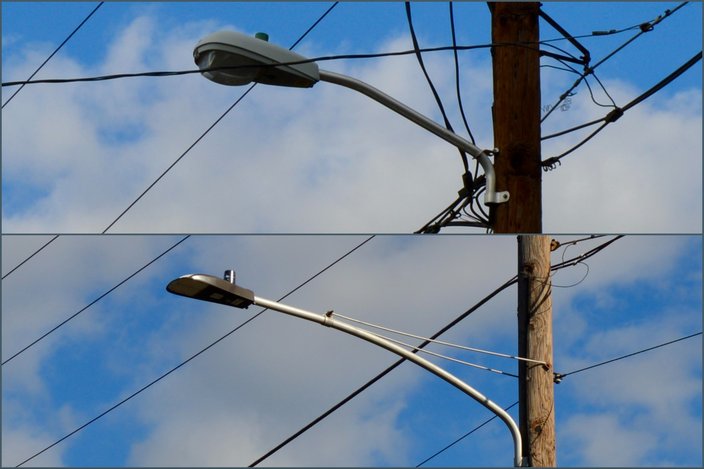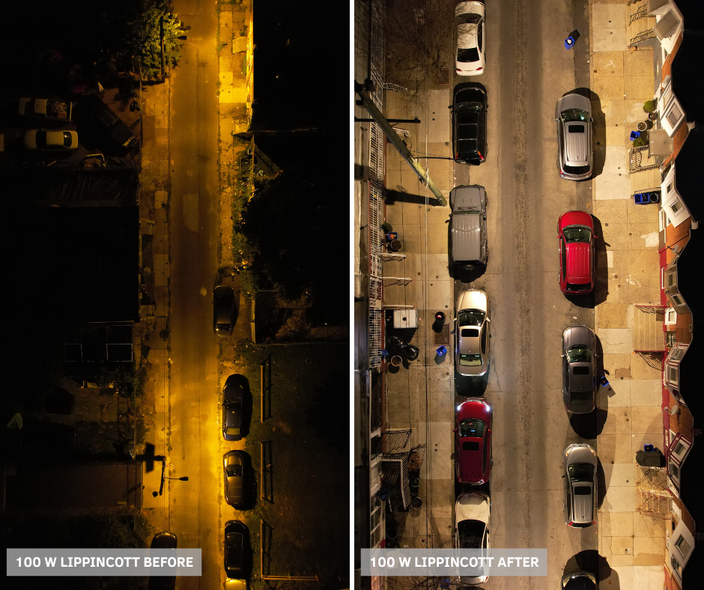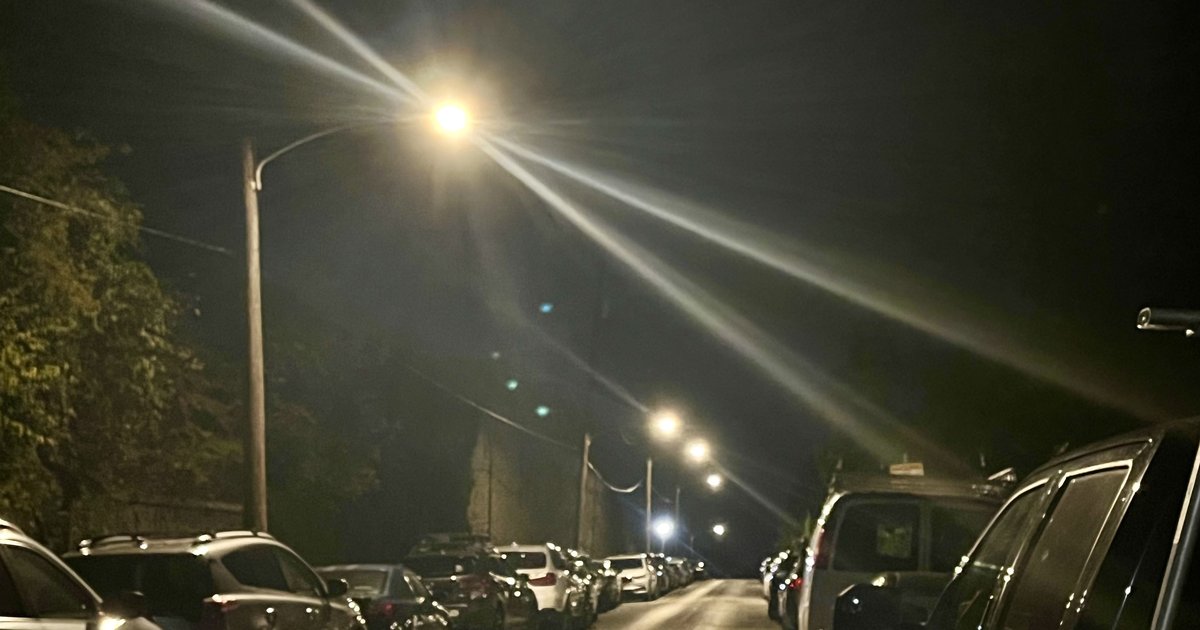Philly’s streetlights are getting an upgrade to keep the city out of the dark. The city has completed a two-year initiative, called the Philly Streetlight Improvement Project, to replace every streetlight with longer-lasting, energy-efficient LED lamps and a management system to track outages.
The project aims to reduce nighttime crime and make neighborhoods safer by keeping streets consistently illuminated. The LED lights also save on electrical costs and last 10 times longer than the old high-pressure sodium streetlights, requiring less maintenance, city officials say.
With the PSIP wrapping up – Philadelphia officials plan to mark the accomplishment at an event Tuesday – here is a guide to what residents should know about the new lights, why the city made this change, and how it is expected to benefit neighborhoods.
What is the Philly Streetlight Improvement Project?
The Philly Streetlight Improvement Project is an initiative by the city of Philadelphia, started in the summer of 2023, to replace over 130,000 high-pressure sodium streetlights on roads and alleyways with LED lights that are brighter, use less electricity and that need fewer repairs.
This is the city’s largest energy conservation project, to date, and is the third project using the Pennsylvania Guaranteed Energy Savings Act, which allows municipalities and other public entities, like school districts, to finance energy efficiency projects based on the energy savings that result from the work. The city also collaborated with the Philadelphia Energy Authority, which issued $91 million in bonds that covered the costs, from prepping neighborhoods and alleyways for the upgrades to the installation of the lights.
The city has a maximum of 20 years to repay the debt, and the PSIP is expected to pay for itself in energy and cost savings.
The new LED fixtures make streets brighter while using less electricity, according to Katie Bartolotta, PEA’s vice president of policy and strategic partnerships. On average, the new cobrahead-style lights produce over 130 lumens per watt of electricity, whereas the high-pressure sodium fixtures were close to 100 lumens per watt.
“This really came out of our city’s municipal Energy Master Plan, and with that, the goal was to reduce energy consumption as a whole, and then increase our ability to do as much renewable electricity as possible,” Dominic McGraw, the deputy director of energy and administration at the City’s Office of Sustainability, said. “It’s kind of like a dual approach of energy efficiency projects and then procuring renewables.”
 Jon Tuleya/PhillyVoice
Jon Tuleya/PhillyVoice
The photo on top shows an high-pressure sodium streetlight that had not yet been replaced. In the bottom photo is a new LED streetlamp the city has installed.
Most of the city’s streetlights are more than 40 years old, and this isn’t the first initiative to innovate the lighting infrastructure. The city had already replaced about 22,000 streetlights during the 10 years leading up to the PSIP, Bartolotta said.
The project also provided nearly 200 jobs to residents through Future Track, the Office of Clean and Green Initiatives’ workforce development program. Among the tasks tackled by the Future Track hires: Crews cleared about 1,800 alleyways to prep for new streetlight installations.
With some extra room in the project, recreational lighting was upgraded in a few parks around the city, including Overington Park and Wissinoming Park.
Just about all of the PSIP work wrapped up within the last week, except for where crews found damaged poles that needed to be repaired before the new lights are installed. City officials are marking the project’s completion with an event Tuesday afternoon at John M. Patterson School in the Elmwood neighborhood of Southwest Philly.
How much energy will the streetlights save?
Because of the new LED lights’ efficiency compared to the high-pressure sodium bulbs, it is estimated the upgrade will reduce the energy used to power streetlights by 50% and cuts energy costs by 25%, saving the city approximately $8 million per year, Bartolotta said.
With these savings, the project will effectively pay for itself in just over 10 years, even as utility costs rise.
“That’s why, for us, I think it was no question of whether we should do a big-scale project to transform this infrastructure,” Bartolotta said, “Because no matter what – even with rising energy prices – having more efficient infrastructure is a really good way to control your spending overall.”
How will the new lights deter crime in my neighborhood?
In neighborhoods that have the new lights, the city is already seeing reductions in crime.
The University Pennsylvania’s Crime and Justice Policy Lab studied the rate of crime between August 2023 and May 2024 on more than 13,000 city blocks where the old streetlights had been replaced early in the PSIP’s work. Researchers found all nighttime outdoor crime on those blocks decreased by 15%. That includes a 21% reduction in gun crimes and a 20% decline in violent crimes.
But it was more than just illuminating neighborhoods better. The new lights were combined with increased law enforcement patrols and “cleaning and greening” efforts in the areas, said Adam Greer, chief public safety director at Philadelphia’s Office of Public Safety, who worked with the Penn researchers.
“All of these things work together with our other law enforcement strategies to reduce crime,” Greer said.
City leaders anticipated the project would have a positive impact on crime, Greer said, and sees it as part of the city’s “holistic” public safety strategy. The brighter lights, along with other community intervention work are part of this strategy to create a safer city.
“The more that we can continue to think about our environmental factors, improving them and how that might relate to things that drive crime,” Greer said, “the better we’re going to be and the more benefit we’re going to see.”
 Provided images/City of Philadelphia
Provided images/City of Philadelphia
This photo shows the 100 block of West Lippincott Street in the Fairhill neighborhood of North Philly. On the left is the block illuminated by the old high-pressure sodium streetlights, and on the right is what the street looks like after the city install new LED lights.
How much do the LED streetlights contribute to light pollution?
It can be difficult to determine the effects one source has on light pollution overall, especially in a major city like Philadelphia, but the new lights are designed to be dark sky compliant, according to McGraw.
Dark sky compliance is a regulation designed to reduce light pollution, preserve night sky environments, and protect wildlife.
The color temperature and brightness of the lights, which were determined through a community survey conducted before the project’s installation phase, are also factors in dark sky compliance.
Will the city add any new streetlights?
The city won’t be adding any new streetlights under the scope of this project. However, PEA is conducting a “lighting equity study” to identify neighborhoods that may require additions.
Utilizing photometry to assess the spread of light from the lamps, the study will identify dark spots and determine where new lamps could be installed to improve illumination.
These new LED lights alone may solve this problem in neighborhoods because they cast a wider spread of light, Bartolotta said.
How do I report outages or request the lights be dimmed?
Reporting outages with old lights was reliant on city workers seeing nonworking streetlight and residents contacting the city to report issues by calling the non-emergency 311 hotline or submitting a report using the 311 website or app. Residents have long expressed their frustrations with the lengthy response times to these complaints.
The LED streetlights are connected to a lighting management system, which immediately alerts officials to outages, allowing them to respond more quickly, removing the need for residents to intervene. The LMS not only alerts the city about an outage but also notes the type of outage to help address it quickly. For example, it can detect whether the bulb is out or if the pole is damaged.
Since the PSIP began, some residents have complained the new lights are too bright or shine directly into their homes. Those issues – and general feedback about the streetlights – can be submitted to 311 or emailed to the city at ledstreetlighting@phila.gov. Upon request, the city can install a shield on light poles to deflect the light away from residences.

